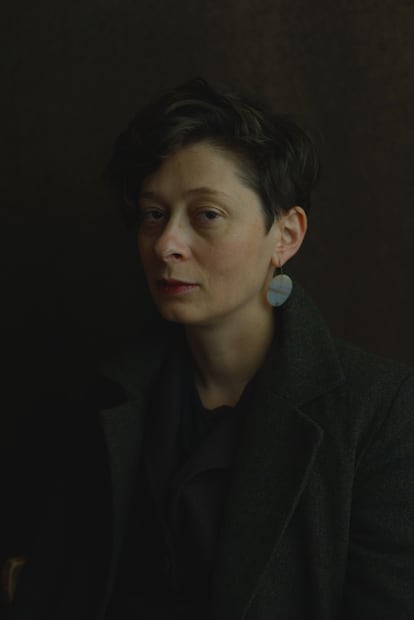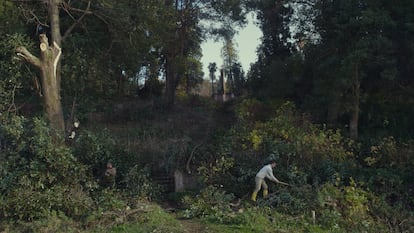‘Taming the Garden’: The strange journey of ancient trees to a Georgian billionaire’s mansion
In a documentary filled with dreamlike lyricism, Salomé Jashi shows how giant specimens are bought, uprooted and replanted in the home of Bidzina Ivanishvili
A century-old tree floats in the middle of the Black Sea. The reflection of its branches on the grey waters only serves to underscore the impossibility of the scene: a 32-foot (10m) tree floating in the sea. On the shore, two locals watch, but they are not surprised: it is not the first time they have seen this kind of scene, and it will surely not be the last. It is a story that has been repeated for some time throughout Georgia, a former Soviet republic located between Russia and Turkey; a story of traveling trees.
We are talking about a movie scene, but it is not a fantasy movie. Taming the Garden is a new documentary by Salomé Jashi, a 41-year-old filmmaker from Tbilisi who told the story of these traveling trees. It begins precisely with that scene: a tree floating under a cloudy sky, on a calm sea. How did it get there? Where does it come from? Where is it going?
Bidzina Ivanishvili is a mysterious character. He is the richest man in Georgia and probably the most powerful one, too: he was elected prime minister of his country in 2012, and only 13 months later he stepped down his post after considering that his job was done. The party he founded, Georgian Dream-Democratic Georgia, has ruled the country ever since. But he lives away from the public eye, to the point that his fellow Georgians wonder whether he continues to reside in the country.

At the top of a mountain next to the old town of Tbilisi there rises an impossible structure, a kind of cross between a Crusader castle and the international airport of a second-rate Arab emirate. It is Ivanishvili’s estate, the residence where he may or may not live: a steel-and-glass fortress that no Bond villain would look down upon. This house contains some of the most valuable works of Western art – the painting by Picasso Dora Maar with Cat was acquired for $95 million at auction in 2006 – and it is surrounded, on the outside, by dozens of century-old trees which have been born in places other than the one they are planted now.
Where others would have only seen a business transaction, Salomé Jashi saw a story to tell. “It’s a delightful story,” she explains. “[Ivanishvili] gathers large ancient trees. He orders his men to uproot those trees and take them to his garden by sea and land. But in the film all of it becomes the story of the powerful and the weak, the rich and the poor.”
“Have you heard the story of the old woman and the tree?” a local man asks another in a scene from the film. They recount how Ivanishvili’s lawyers turned up one day at the home of an elderly woman. They asked her how much she wanted for the tree and the woman said “four hundred.” Four hundred lari is almost €120. “Four hundred thousand is a lot, we can give you 40,000.” The old woman, of course, sold the tree.
It is a story that could have been taken from One Thousand and One Arabian Nights, or from a tale by Charles Perrault or by the Brothers Grimm: you would only need to change Ivanishvili for an emir or a prince. His emissaries appear one day and offer fantastic amounts for some trees that their owners do not value. Trees that shaded the orchard or littered the garden with leaves. But as usually happens in fairy tales, all that glitters is not gold.
Transporting gigantic trees is not an easy task. The roads are narrow and surrounded by houses and more trees. In order to move a tree from its place, you have to chop down the ones that are in the way. Some fences have to be removed. Uprooting work requires months. A man complains to the lawyers that they have been bothering him and his neighbors for a long time. The lawyers reply: “You signed a contract.” The man argues and walks away, making vague threats.

But the film does not take sides. “I think the public is smart enough to connect the dots, make judgments, think, ponder. I’m not a fan of one-dimensional answers, because in life they don’t really exist. How am I going to reach a conclusion in 90 minutes?” argues the filmmaker.
Certainly, it is a complex matter. For every felled tree, there is a repaired road, or a shored-up slope. The lawyers will leave, but the improved infrastructure will remain. Neighbors get more than just money, but they also lose more than just a tree. A woman cries. “So many generations have played under that tree,” she says. In another scene, a man exclaims: “Are we really running out of trees?” Looking around him, we can see that’s not the case.
There are few dialogues in this story. The scenes that follow one another are a testament to the engineering work involved in transporting the trees. Trees that make their way among other trees, advancing very slowly but unstoppably. Around the trees, people seem tiny. It could be seen as the triumph of humanity over the world. It could be seen as the will of a rich man overriding the natural order of things. Jashi chooses not to. She chooses to show the facts with an almost dreamlike lyricism, as if it were a legend or a fable.
“Many different movies could have been made about this event,” says Jashi. “We could have made a movie focused on the rich man, showing him, talking about his hobbies. We could have made an investigative film about the somewhat suspicious role of the state in this process. It is such a big story that a single movie is not enough to tell it. We could have tied the film to a specific moment in time, but I was curious about the metaphorical, symbolic and poetic connotations.”
A gardener waters the transplanted tree. It has passed from the chaos of rural villages to the domesticated order of Ivanishvili’s garden. It seems like it’s been there forever. We do not see the villagers again. We do not know what has happened to their fences, their houses and their roads. Ivanishvili Garden opened to the public in 2020. Visitors make guesses. Why this obsession with trees? Some think Ivanishvili may be a druid that uses the trees in arcane rituals; others think it is simply a display of his power, something he does because he can, in order to show that, despite not having held any political office for years, he can still widen roads and stop trains on a whim.
There are no answers to those questions. The only person who could provide them has no intention of doing so. That is why Jashi refuses to provide context, to draw conclusions. Instead, she prefers to present us the impossible image of a century-old tree, surrounded by mist, floating in the middle of the Black Sea.
‘Taming the Garden’ is available on the streaming platfom Mubi.
Tu suscripción se está usando en otro dispositivo
¿Quieres añadir otro usuario a tu suscripción?
Si continúas leyendo en este dispositivo, no se podrá leer en el otro.
FlechaTu suscripción se está usando en otro dispositivo y solo puedes acceder a EL PAÍS desde un dispositivo a la vez.
Si quieres compartir tu cuenta, cambia tu suscripción a la modalidad Premium, así podrás añadir otro usuario. Cada uno accederá con su propia cuenta de email, lo que os permitirá personalizar vuestra experiencia en EL PAÍS.
¿Tienes una suscripción de empresa? Accede aquí para contratar más cuentas.
En el caso de no saber quién está usando tu cuenta, te recomendamos cambiar tu contraseña aquí.
Si decides continuar compartiendo tu cuenta, este mensaje se mostrará en tu dispositivo y en el de la otra persona que está usando tu cuenta de forma indefinida, afectando a tu experiencia de lectura. Puedes consultar aquí los términos y condiciones de la suscripción digital.

